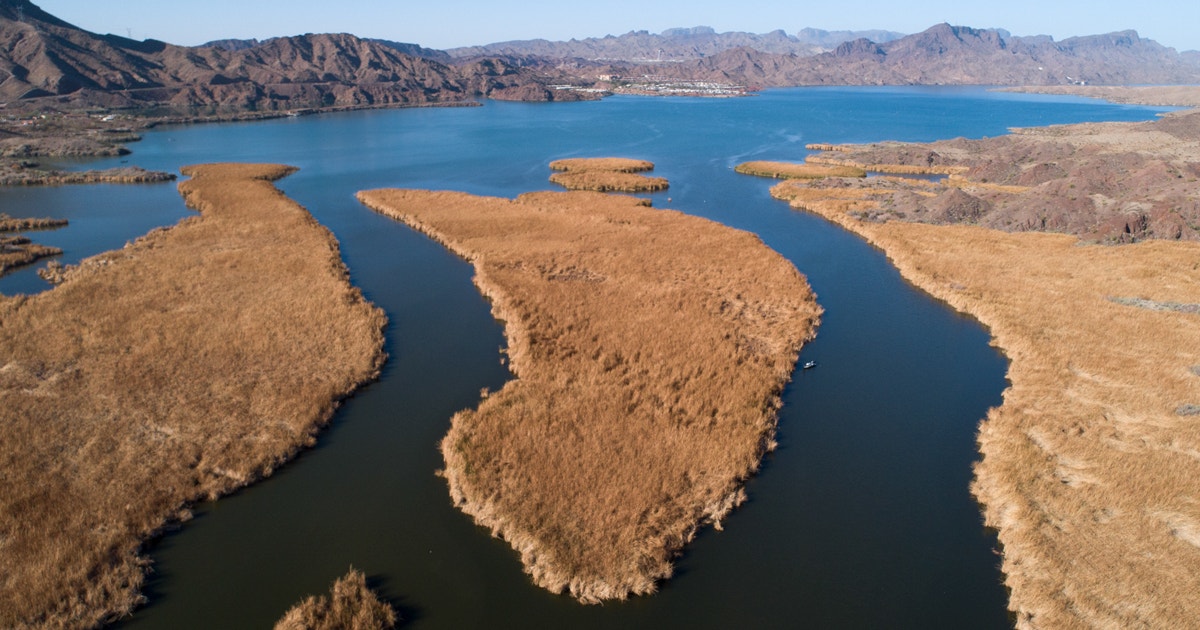Close your eyes. Picture the vibrant healthy ecosystems of the Colorado River Basin. You might envision the northern part of the watershed—thriving native fisheries in Wyoming’s Green River, the sweet song of the Yellow Warbler emanating from dense native riparian vegetation flanking the banks of smaller tributaries in Utah, or maybe the undammed, free flowing stretches of the Yampa River in Colorado. The northern half of the watershed, though rife with dams and diversions, largely resembles a more natural environment—the rivers swelling with runoff as the snow disappears from the surrounding peaks, and native vegetation dominating much of the riparian zone, creating quality habitat for birds and other wildlife.
The southern part of the Colorado River Basin presents a different picture. Hydropower—as well as water orders for cities and farms in Arizona, California, and Mexico—determine the amount and timing of flows in the Colorado River causing the river’s ecosystems to decline. Audubon’s Water and Birds in the Arid West reported that though these riparian areas account for a tiny portion of the Basin (5%), they are home to a large percentage of the birds in the region (40% of all species); and, because of the decline, species such as Bell’s Vireo and Western Yellow-Billed Cuckoo are increasingly threatened.
But that is not how it has always been. Before the Hoover and Glen Canyon Dams were built, the Lower Colorado River supported extensive forests of cottonwoods, willows, and mesquite trees that extended miles away from the riverbed. Spring flooding driven by snowmelt facilitated new growth by spreading the seeds of the existing native vegetation, while also recharging the groundwater table so that it reached plants’ root systems closer to surface, keeping both new and old growth alive. These lush floodplain habitats attracted a variety and abundance of bird species, especially birds that preferred riparian, marsh, and open water areas in flooded side channels. Migratory birds heavily relied upon this corridor when journeying between breeding and wintering grounds—some even staying in the area to breed.
After decades of diversions from water users below Hoover Dam, depleting the river’s flow and altering its’ natural timing, these ecosystems are struggling. In some areas of the Lower Colorado River, up to 80% of cottonwood and willow forests have disappeared, and the story is the same with mesquite forests. In many places, the incredibly invasive salt cedar (also known as tamarisk) is outcompeting native vegetation. As areas of dense riparian vegetation disappeared, so too did the birds reliant on that habitat type—replaced by species more suited to open fields and agricultural areas.
In response to these changes, the U.S. Bureau of Reclamation and water users in California, Nevada, and Arizona were forced to take action to address the detrimental impact that declining flows from ongoing river operations were having on federally threatened and endangered species with critical habitat along the Lower Colorado River. In 2005, they partnered to launch the Lower Colorado River Multi-Species Conservation Program (LCR MSCP) in order to secure Endangered Species Act compliance for river operations below Hoover Dam. The LCR MSCP works toward this goal by creating beneficial riparian and aquatic habitat specifically targeted to support the well-being of 27 threatened, endangered, and species of interest identified in the program. This list includes 12 birds (like the California Black Rail and Gila Woodpecker), 4 fish, and 8 reptiles and small mammals, 2 plants, and 1 insect species. Today, the LCR MSCP currently stewards 18 conservation areas that total 7,195 acres of restored marsh, backwater, cottonwood-willow forest, and mesquite habitat.
Climate change is exacerbating droughts, and the multi-decadal downward trend in Colorado River flows is forcing Colorado River water users to reevaluate how much of the river’s water can be used and how to manage the river for future resiliency. We expect a major shift in a new set of rules that will be adopted in 2026 driven by increasing recognition of the permanent and increasing impact of climate change on Colorado River flows. Colorado River water users have already agreed to use 3 million acre-feet less water from now until 2026, all of which will occur in the Lower Basin below Hoover Dam; conserved water will remain in Lake Mead and flows in the Lower Colorado River will be further reduced. As a result, LCR MSCP committed to additional actions to mitigate impacts of these smaller flows available to support important Lower Colorado River riparian habitat.
It is reasonable to expect that the post-2026 rules will include reductions similar to, or larger than, the magnitude of current commitments in the Lower Basin. LCR MSCP habitats rely on irrigation water, and Audubon will advocate for those sites to continue receiving the water necessary to support these created habitats if their water source is impacted. In addition, more permanently reduced flow regimes in the Lower Colorado River corridor could lead to additional losses to remnant quality habitat (not created by LCR MSCP), necessitating expanded habitat mitigation through the program. Audubon is keeping an eye on how new management rules will impact LCR MSCP sites and other habitat along the Lower Colorado River. We will keep you in the loop as the post-2026 rules process develops and let you know when your voices will be needed to advocate for these important places. In the meantime, we encourage you to enjoy and take care of these special places.

